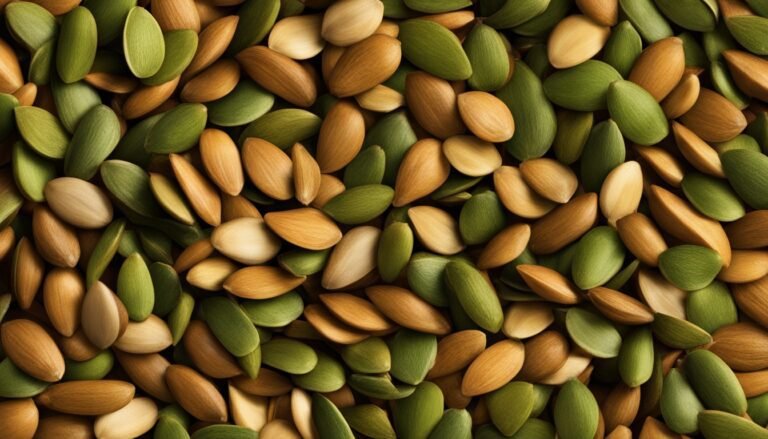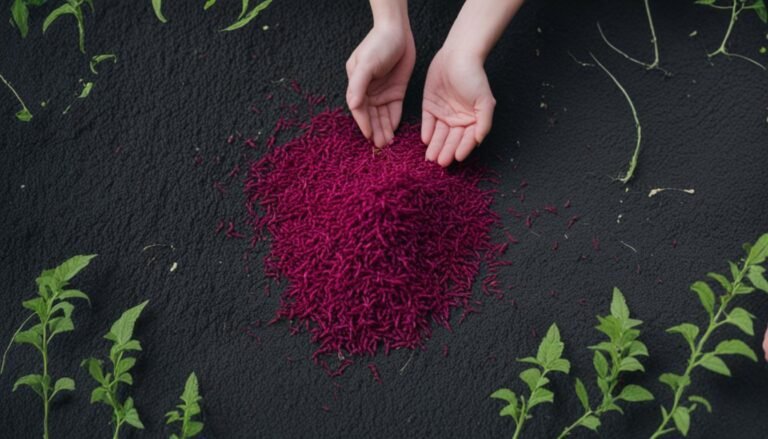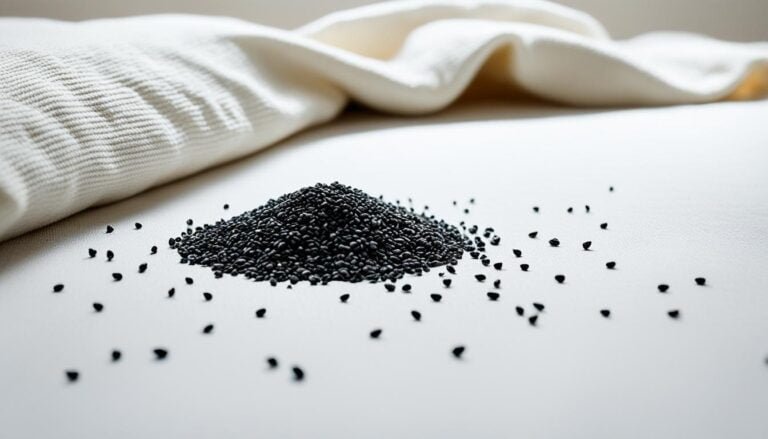Discover the Health Benefits of Amaranth Seeds

Amaranth seeds are super rich in protein, almost twice as much as corn or rice. It’s no surprise that it’s popular among health lovers. This superfood is both nutritious and can be used in many ways in the kitchen. Let’s find out why amaranth is such a great choice for our health.
Introduction to Amaranth Seeds
Ancient people in Central America loved amaranth seeds in their diet. It was a key part of the Aztecs’ food and it’s still loved in that region today. The name “amaranth” means “unfading” in Greek, which fits well with its bright flowers that don’t wilt easily.
The Ancient Grain with Vivid Crimson Flowers
Amaranth is known for its striking appearance. It has tall stalks and its vivid flowers are like sparks of color, which have made it popular with people who care about their health around the world. This plant grows in many places, from zones 2 to 11. Plus, it’s tough, thriving in all kinds of soil, even poor ones.
A Staple Food of the Aztecs
For the Aztecs, amaranth was a lot more than pretty. It was a major part of their meals, rich in nutrients. Amaranth seeds have a lot of protein, more than most other grains at 14 to 16%. What’s more, they are full of a vital amino acid called lysine.
In the 1970s, amaranth was introduced to the US mainly targeting health food lovers. Nowadays, its popularity is growing as people see its wide range of nutrients and how well it works in recipes.
Nutritional Profile of Amaranth Seeds
Amaranth seeds are full of nutrients, including high protein, fiber, and micronutrients. This ancient grain is known for its balanced nutrition, perfect for a healthy diet.
Rich in Protein, Fiber, and Micronutrients
One cooked cup of amaranth has 4.7 grams of protein, more than corn or rice. Protein is key for muscle health and keeping our blood strong.
Amaranth is also packed with 2.6 grams of fiber per cup. This helps you feel full and keeps your digestion in check.
It’s not just about protein and fiber. Amaranth is rich in micronutrients like manganese, magnesium, phosphorus, iron, and vitamin B6. A quarter-cup serving offers your daily manganese needs. Manganese helps over 300 body functions, including immune system and hormone balance.
| Nutrient | Amount in 1/2 cup cooked amaranth |
|---|---|
| Calories | 125.5 |
| Fat | 1.9g |
| Carbohydrates | 23g |
| Fiber | 2.6g |
| Starch | 20g |
| Protein | 4.7g |
| Iron | 2.6mg |
| Magnesium | 80mg |
| Vitamin B6 | 0.1mg |
| Folate | 27.1mcg |
Amaranth’s nutrient-rich content makes it great for your diet. It’s helpful if you want more protein, fiber, or micronutrients in your meals. Add amaranth seeds to your food for an easy nutrition boost.
Amaranth Seeds: A Naturally Gluten-Free Option
Finding good food when you can’t eat gluten can be hard. Amaranth seeds offer a great gluten-free choice. They don’t have gluten, a protein that bothers people with certain diseases.
Amaranth has been eaten in the Americas for more than 8,000 years. It’s good for you and can be used in lots of recipes. You can cook it as porridge, add it to soup, or make muffins with amaranth flour.
A big plus of amaranth is that it has all the protein your body needs. It also has important fiber, minerals, and antioxidants. These are good for everyone, not just those avoiding gluten.
| Nutrient | Amount per 100g |
|---|---|
| Energy | 1565 kJ/374 Kcal |
| Protein | 14.5g |
| Fat | 6.5g |
| Carbohydrates | 56.8g |
| Dietary Fiber | 9.3g |
The little grains of amaranth are like caviar and can be used in many dishes. You can pop them like corn, toast them, or make sweets. They mix well with other foods, making your meals interesting.
Are you gluten-free or looking for something new and healthy? Amaranth seeds are a great choice. They bring variety and nutrients to your diet. Plus, they have a long list of health benefits.
Antioxidant Properties of Amaranth Seeds
Amaranth seeds stand out for their amazing benefits beyond just nutrition. They are packed with antioxidants like gallic acid and vanillic acid. These fight free radicals and cut down inflammation.
Many studies have explored amaranth’s strong antioxidant power. A 2019 study showed amaranth’s antioxidant effect shifts during the plant’s life. The best stage was at flowering. In 2020, a different report praised Amaranthus’ antioxidant abilities, hinting at their goodness for health.
Amaranth’s antioxidant benefits were also noted in a 2011 report, suggesting they could help fight common illnesses. Later, a 2018 study looked at amaranth oil for metabolic problems linked to obesity. Lastly, a 2021 trial compared amaranth oil with rapeseed oil for heart health in overweight people. Here, amaranth oil showed it might be good for the heart.
What makes amaranth so good at fighting off free radicals is its unique mix of chemicals. For example, betalains not only make the plant look red but also help it scavenge free radicals. Moreover, the bioactive peptides from its proteins are good for preventing long-term diseases. All these elements make amaranth a top pick for boosting health.
Adding amaranth to your meals is an easy way to get more antioxidants. It’s great for fighting age signs, keeping inflammation low, or just staying healthy. This ancient grain can make a big difference in your health journey.
Potential Benefits of Amaranth Seeds for Cholesterol Management
New studies show that amaranth seeds and oil might help with lowering cholesterol. These benefits come from reducing bad cholesterol (LDL) but not good cholesterol (HDL).
In one study, amaranth oil was fed to hamsters and it reduced their total and LDL cholesterol. The percentages were 15% and 22% lower, in that order. A chicken study found that amaranth in their diet cut total cholesterol by 30% and LDL by an impressive 70%. These findings suggest amaranth could improve heart health by balancing cholesterol levels.
The secret to amaranth’s success is its rich nutritional mix. It has a lot of protein, fiber, and beneficial unsaturated fatty acids. These elements help in managing cholesterol.
Although animal studies are encouraging, we need more research on humans. Still, the signs are good. Adding amaranth to your meals could naturally help control cholesterol. This could lower the chance of heart problems.

Remember, amaranth isn’t a medicine on its own. It can’t replace what your doctor prescribes for managing cholesterol. Always talk to your doctor before big diet changes or trying new foods if you have high cholesterol.
Amaranth Seeds for Weight Loss
Amaranth is an ancient superfood that might help you lose weight. It’s packed with protein and fiber. Both of these are super important for managing your weight. They help you stay full longer.
High Protein and Fiber for Satiety
Amaranth seeds are rich in protein. This can cut down on your hunger. You’ll feel full for an extended period. This is because protein reduces the hunger hormone, ghrelin.
On top of that, the fiber in amaranth moves slowly through your body. It helps you stay full too. By not being hungry as often, you might eat less. This is an excellent boost for your weight loss journey.
| Nutrient | Amount per 100g of Amaranth Seeds |
|---|---|
| Protein | 14g |
| Fiber | 6.7g |
We still need to learn more, but signs point to amaranth seeds being great for weight loss. Eating them could lower how much you eat. This is because they make you feel full. Pairing amaranth with good diet and exercise might help you lose weight.
Versatile Uses of Amaranth Seeds
Amaranth is a truly versatile grain that can be prepared and utilized in many tasty ways. It has a nutty, slightly sweet taste that fits well in both cooking and baking. You can enjoy it in dishes like porridges and snacks for a crunchy twist.
A popular use for amaranth seeds is making a warm porridge like oatmeal. They are small and round, which works great in soups and stews to add thickness. It’s also fun to pop amaranth seeds, giving you a popcorn-like snack.
Amaranth flour is a standout when it comes to baking. Replace standard flour with it in recipes like bread, muffins, and cookies for a different taste. It’s also a good option if you’re looking for a gluten-free alternative. Plus, you can add it to smoothies or sprinkle it on yogurt and cereal, boosting your meals with extra nutrients.
Whether you want to cook or bake with amaranth, there are countless ways to use it. Its unique taste and rich nutrients make it a favorite for many.
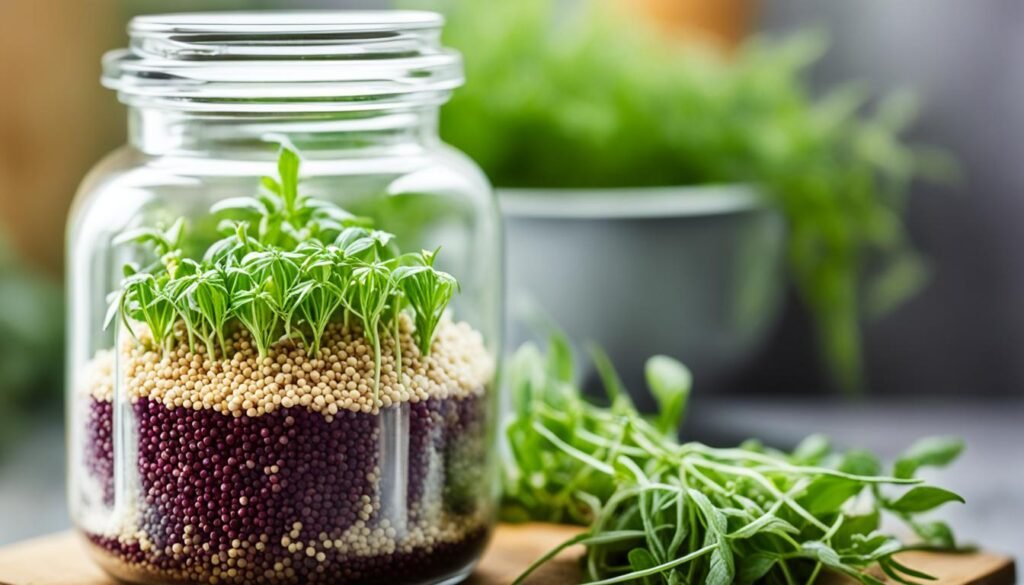
- Boiling into a porridge or cereal
- Popping like popcorn for a crunchy snack
- Substituting amaranth flour in baked goods
- Blending into smoothies
- Sprinkling over yogurt or salads
- Adding as a thickener in soups and stews
Amaranth’s superior versatile nature, rich nutrients, and delightful taste make it a superfood for every kitchen.
Amaranth Seeds: A Gluten-Free and Vegan Protein Source
Amaranth is a powerhouse that is gluten-free and loaded with plant-based protein. This pseudo-cereal has all the essential amino acids, making it a complete protein. It’s therefore great for those on gluten-free or vegan diets aiming to add protein to their meals.
This food has been a part of diets for about 8,000 years. It’s valued not only for its protein but also for its fiber, vitamins, and minerals. You’ll find good amounts of vitamin C, lysine, and key nutrients like iron, magnesium, and phosphorus here.
Amaranth is incredibly adaptable. You can add it to porridge, baking, or enjoy it as a snack. With its organic and gluten-free certifications, choosing amaranth means choosing health.
| Product | Rating | Reviews | Price |
|---|---|---|---|
| HerbaZest Amaranth Pop Organic | 4.5 out of 5 stars | 137 reviews | $13.95 – $36.99 |
| Bob’s Red Mill Organic Amaranth Grain | 4.5 out of 5 stars | 945 reviews | $13.95 – $36.99 |
| HerbaZest Amaranth Flakes Organic | 4.4 out of 5 stars | 347 reviews | $13.95 – $36.99 |
| Food to Live Amaranth Grain | 4.3 out of 5 stars | 78 reviews | $13.95 – $36.99 |
Amaranth is a gem for those wanting to live healthy. It boosts protein, adds whole grains and just tastes good. So, for anyone health-focused, trying amaranth is a smart move.

Cooking and Preparing Amaranth Seeds
Amaranth is an ancient grain that offers lots of ways to cook it. You can make anything from a cozy porridge to yummy baked items. It’s perfect for those on a gluten-free diet or who just love trying new foods. Cooking with amaranth seeds is fun and fulfilling.
Cooking Whole Amaranth Grains
To cook whole amaranth grains, use a 3:1 ratio of water to grains. Start by boiling the water, then lower the heat and let the amaranth simmer. Stir every so often. After about 20 minutes, the water will be gone, and the grains will be soft and fluffy.
This cooked amaranth is great in many dishes:
- Hearty breakfast porridge, topped with fresh fruit, nuts, and a drizzle of honey
- Nutrient-dense salads, adding texture and protein
- Flavorful soups and stews, allowing the grains to soak up the delicious broth
Baking with Amaranth Flour
Amaranth flour is a tasty option for baking. It gives muffins, bread, and others a nutty, sweet taste. When using amaranth flour, substitute it for up to 25% of the regular flour in your recipe. This way, you get to enjoy its flavor and benefits without changing how your baked goods turn out.
| Amaranth Nutrition Facts (1 cup, cooked) | Amount |
|---|---|
| Calories | 251 |
| Protein | 9g |
| Carbohydrates | 46g |
| Fiber | 5g |
| Calcium | 116mg |
| Iron | 5mg |
Amaranth is not only nutritious but also very flexible. Whether you’re cooking it for a porridge or using it in flour for baked goods, this superfood will bring something special to your cooking.
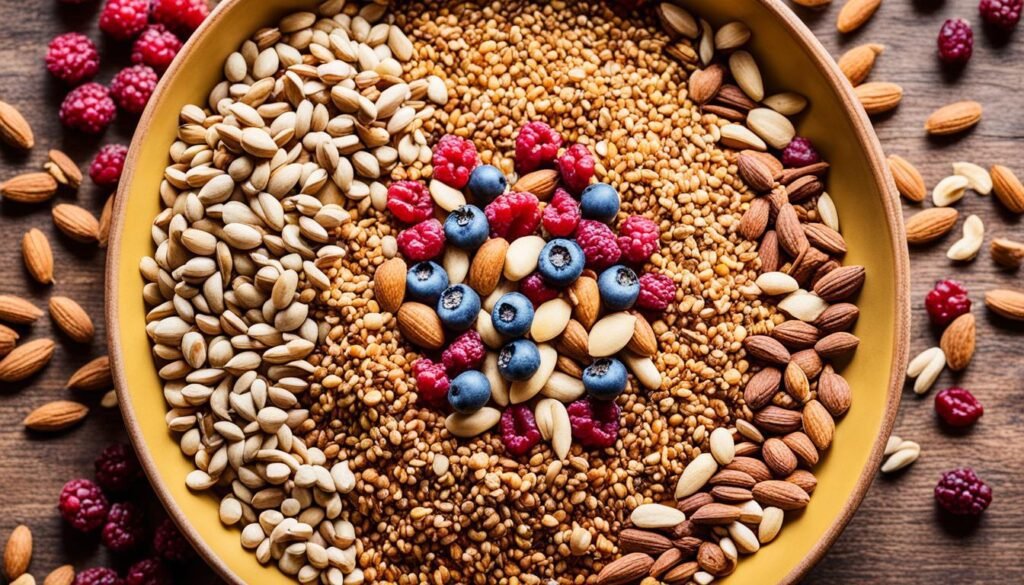
Sourcing and Storing Amaranth Seeds
Amaranth is now easy to find in the United States. It’s available year-round in stores, even though it grows from summer to winter. The seeds come dried in packages.
In the US, you’ll find amaranth seeds in many places. For example, South American stores, health food shops, and regular supermarkets. These small seeds are full of protein, fiber, and important vitamins.
To keep amaranth seeds fresh, store them in a cool, dry spot. An airtight container works best. They will keep their nutrition for about 6 months like this. You can also turn the seeds into flour and freeze it. This gives you up to 9 months of shelf life.
Amaranth is a strong, adaptable plant. There are 60-70 types, with 40 from the Americas. Notable varieties are A. hypochondriacus, A. cruentus, and A. tricolor.
| Amaranth Variety | Seed Color | Shelf Life |
|---|---|---|
| A. hypochondriacus | Off-white to pale pink | Up to 6 months |
| A. cruentus | Off-white to pale pink | Up to 6 months |
| A. tricolor | Black and shiny | Up to 6 months |
Collecting amaranth seeds takes care. They’re ready about three months after planting, around mid-summer. When they easily fall from the plants, they’re ripe. Dry them well and store in a sealed container to keep them fresh.
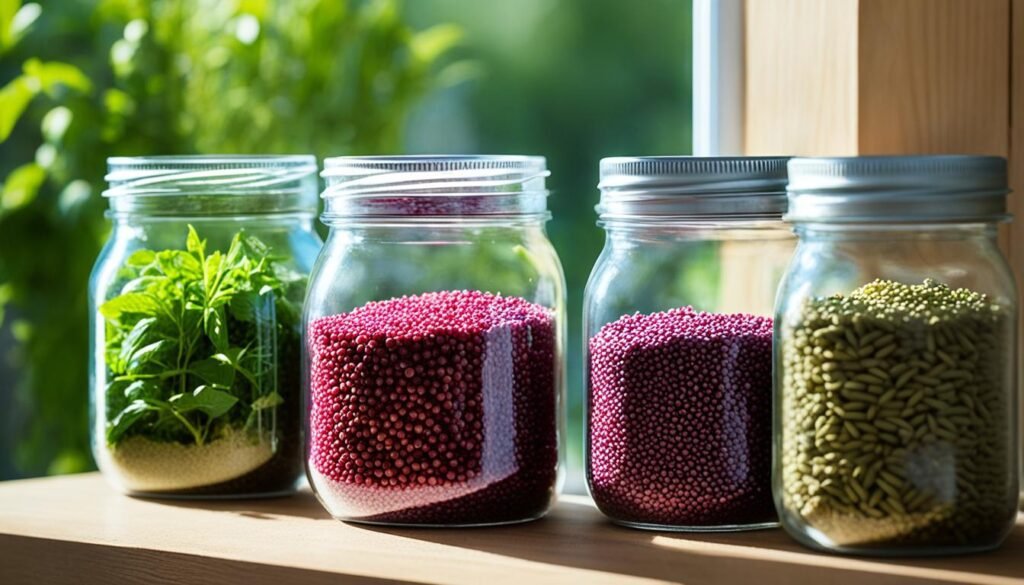
Amaranth is a standout grain for its nutrients and long life. Learn how to source and store it correctly. This way, you can enjoy the benefits of this ancient food for a long time.
Conclusion
Amaranth is an old but powerful grain, packing a lot of nutrition. It has lots of protein, fiber, and important minerals. These include manganese, magnesium, and iron. Plus, it’s gluten-free. It has antioxidants that fight inflammation and may lower cholesterol.
Amaranth is great for many things, like cooking and baking. It’s perfect for anyone wanting more protein, better cholesterol, or just a tasty, healthy option. Adding it to your meals is an awesome way to use this superfood.
Here is a quick look at its benefits: high protein, free of gluten, antioxidative, and it helps with cholesterol. This nutritious ancient grain can really change up your diet for the better. It’s also very flexible in recipes.
Using amaranth opens up a whole new world of food possibilities. It not only tastes great but it’s also super good for you. Try adding it to your dishes and see how amazing it can be for your health.
FAQ
What is the meaning of the word “amaranth”?
Amaranth comes from the Greek word for “unfading”. This name hints at the plant’s bright crimson flowers that last all summer.
Where is amaranth native to?
Originating from Mexico and Central America, amaranth was a key food for the Aztecs. It still enjoys a place in traditional Central American meals.
Why has amaranth become more popular in the U.S.?
Its amazing nutritional benefits have sparked interest across the U.S. That’s why many more people are enjoying amaranth.
How is amaranth rich in protein?
Amaranth offers a lot of protein—it has nearly twice as much as corn or rice. This nutrient is crucial for healthy muscles and blood.
What other nutrients are found in amaranth?
In addition to protein, amaranth is packed with nutrients like manganese, magnesium, phosphorus, and iron.
Why is amaranth a good option for those with gluten sensitivity?
Being naturally gluten-free, amaranth is great for people with celiac disease or a gluten sensitivity.
What antioxidants are found in amaranth?
This grain is loaded with antioxidants such as gallic acid and vanillic acid. They can battle free radicals and lessen inflammatory effects.
How does amaranth affect cholesterol levels?
Studies suggest that amaranth may lower bad cholesterol without decreasing the good kind. This is good news for your heart health.
How can amaranth help with weight loss?
Its protein and fiber aid in losing weight. Protein reduces appetite, and fiber keeps you feeling full.
How can amaranth be used in cooking and baking?
You can make amaranth into porridge, pop it like corn, add it to smoothies, or swap it with flour in baking.
Is amaranth a complete protein source?
Yes, amaranth is considered a complete protein because it contains all the essential amino acids.
How do you cook and prepare amaranth?
For whole grain amaranth, cook in a pot with water using a 3:1 ratio for about 20 minutes. It’s also great as flour in baking.
When is amaranth in season and where can it be found?
Amaranth grows from midsummer until the first frost. While it’s usually sold dried, you can find it year-round. Look in Latin American grocery stores, health food stores, farmers’ markets, and big supermarkets in the U.S.


